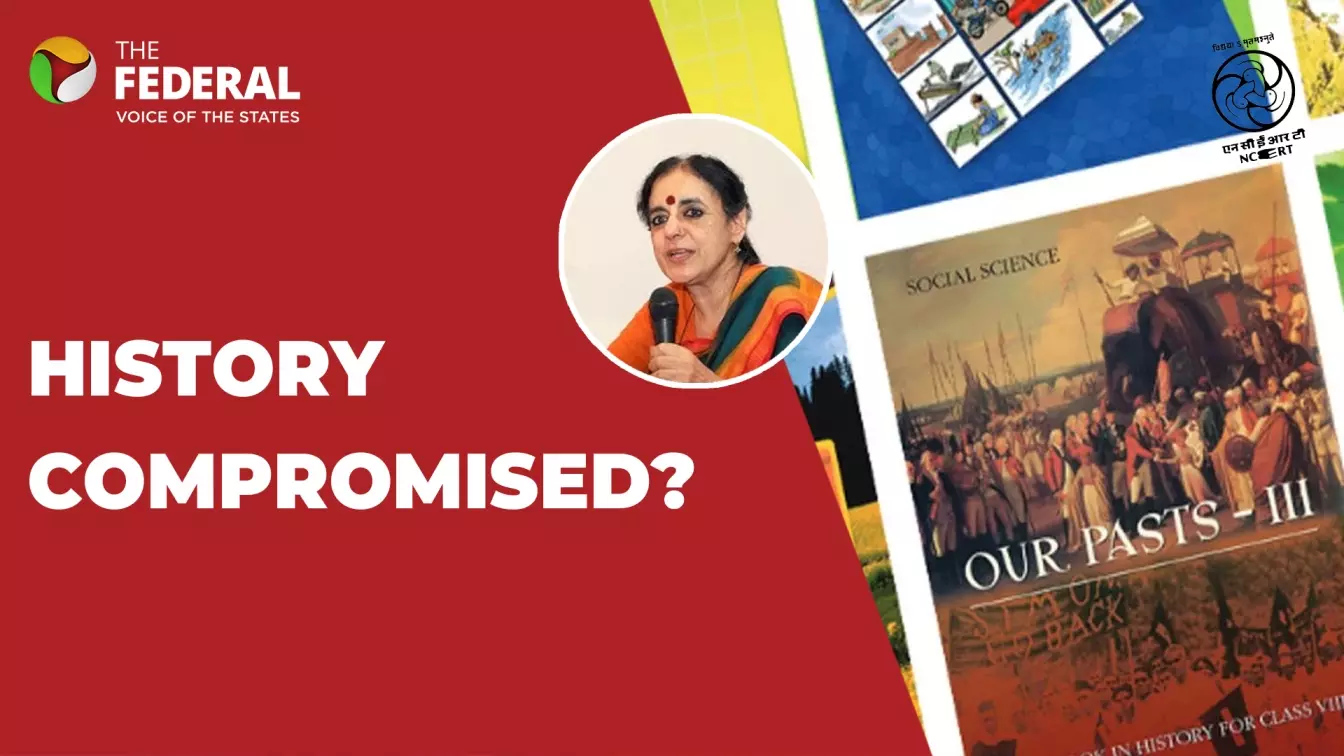
Exclusive: Prof. Anita Rampal on NCERT textbook revisions
Prof. Anita Rampal says the revisions in the textbook, coupled with the broader shifts in educational policy, suggest a move towards homogenising India's diverse narratives

The National Council of Educational Research and Training (NCERT) has recently revised its Class 7 Social Science textbook, "Exploring Society: India and Beyond", sparking widespread debate. The updated edition omits significant historical periods, notably the Delhi Sultanate and the Mughal Empire, and introduces concepts like "sacred geography" and references to events such as the Mahakumbh. These changes have raised concerns among educators and historians about the potential implications for students' understanding of India's diverse history.
In this exclusive interview with The Federal, Professor Anita Rampal, former Dean of Delhi University's Faculty of Education, talks about NCERT textbook revisions.
Also read: Mughals, Delhi Sultans vanish from Class 7 NCERT books, Maha Kumbh enters
Q: What are your key takeaways from the revised Class 7 Social Science textbook?
Anita Rampal: The revisions appear to be a deliberate attempt to distort and erase significant aspects of social sciences. In history, for instance, there's a selective focus on certain periods and characters, while others are conspicuously omitted. Geography is presented with a lens that emphasises myths and legends without clarifying their context, leading to confusion between factual content and folklore. Such approaches can obscure students' understanding of historical and geographical concepts.
Q: The textbook omits references to the Mughals and the Delhi Sultanate. What's your perspective on this?
Rampal: Traditionally, Class 7 covers medieval Indian history, including the Delhi Sultanate and the Mughal Empire. Their omission is a significant deviation from established curricula. The textbook now focuses on periods like 1900 BCE to 300 BCE, which raises questions about the rationale behind such selective historical representation. This cherry-picking disrupts the continuity of India's rich and diverse historical narrative.
Q: The term "sacred geography" has been introduced. How do you interpret its inclusion?
Rampal: The concept is presented without adequate explanation, suggesting that the entire Indian landscape is interconnected through sacred sites like the Char Dham and Shakti Peethas. While these are significant in certain religious contexts, presenting them as geographical facts without clarifying their mythological origins blurs the line between faith and empirical study. This approach can mislead students about the nature of geographical studies.
Q: Have you noticed an increased use of Sanskrit terms in the English version of the textbook?
Rampal: Yes, there's a noticeable Sanskritisation, with numerous terms introduced without adequate explanation. This can be challenging for students from diverse linguistic backgrounds. Moreover, the textbook dedicates sections to teaching pronunciation and diacritical marks for these terms, which seems unnecessary and could detract from the core learning objectives.
Q: What are your thoughts on the removal of Environmental Studies from the primary curriculum?
Rampal: The elimination of Environmental Studies (EVS) is concerning. EVS has been instrumental in integrating science, social studies, and environmental education at the primary level. Replacing it with a vague subject like "The World Around Us" lacks clarity and undermines the interdisciplinary approach that EVS championed. This change could hamper students' holistic understanding of environmental issues.
Q: The textbook now combines history, geography, and civics into one. Is this integration effective?
Rampal: While interdisciplinary learning is beneficial, the current integration seems superficial. Instead of a cohesive blend, the subjects are presented in isolated chapters, missing the opportunity to explore interconnected themes. For effective interdisciplinary education, themes should transcend individual subjects, fostering a more comprehensive understanding.
Q: Do these textbook changes reflect a broader agenda within the National Education Policy (NEP)?
Rampal: Indeed, the NEP's emphasis on certain values over constitutional principles is evident. For instance, values like cleanliness and sacrifice are prioritised, while fundamental constitutional values like liberty and fraternity are relegated. Additionally, the policy's push for vocational education at early stages and the centralisation of educational content raise concerns about equity and inclusivity in education.
Q: Any final thoughts on the implications of these changes?
Rampal: The revisions in the textbook, coupled with the broader shifts in educational policy, suggest a move towards homogenising India's diverse narratives. This not only undermines the richness of our multicultural heritage but also risks alienating communities by marginalizing their histories and contributions. Education should be a tool for inclusivity and critical thinking, not a means to propagate a singular narrative.
(The content above has been generated using a fine-tuned AI model. To ensure accuracy, quality, and editorial integrity, we employ a Human-In-The-Loop (HITL) process. While AI assists in creating the initial draft, our experienced editorial team carefully reviews, edits, and refines the content before publication. At The Federal, we combine the efficiency of AI with the expertise of human editors to deliver reliable and insightful journalism.)

